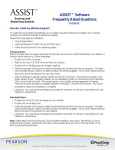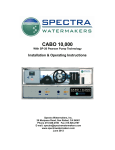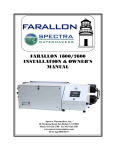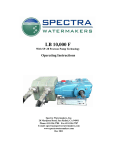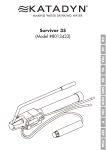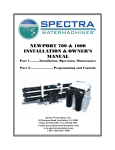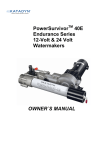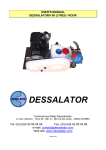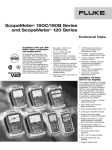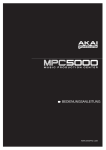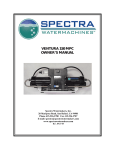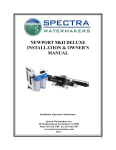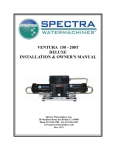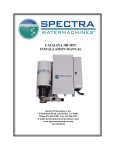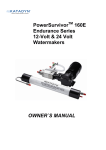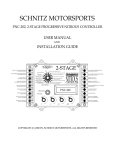Download LB 1800/2800 F User Manual
Transcript
LB 1800 F LB 2800 F Seawater Desalinator OPERATOR’S MANUAL 11/11 mpc5000 B-15 2 Table of Contents Part 1 Page Number Installation Installation ....................................................................................................................................................... 5 Optional Equipment ...................................................................................................................................... 10 Tank Switch Installation ............................................................................................................................... 11 Operation New Systems Start Up and Testing................................................................................................................15 Normal Start Up .............................................................................................................................................18 Start Up Using the ‘Stop’ Button ...................................................................................................................19 Monitoring the System ...................................................................................................................................20 Manual Operation...........................................................................................................................................21 Service & Maintenance Long Term Storage Procedures......................................................................................................................23 Winterizing.....................................................................................................................................................25 Maintenance ...................................................................................................................................................26 Oil Changes ....................................................................................................................................................27 Membrane Cleaning .......................................................................................................................................28 Salinity Probes................................................................................................................................................29 Troubleshooting Procedures...........................................................................................................................30 Wiring Schematics .........................................................................................................................................32 Bulletins..........................................................................................................................................................37 Spectra Pearson Pump - Exploded View........................................................................................................41 Part 2 Controls MPC-5000 Operation Guide (High/Low Run Speed Mode)............................................................................5 General Operation ............................................................................................................................................6 Programming from the Display......................................................................................................................14 Salinity Probe Calibration ..............................................................................................................................17 Detailed Controls Data ...................................................................................................................................18 SN’s 1139 3 4 Getting Started Unpack the system and inspect it to make sure that it has not been damaged in shipment. Refer to the shipping list for your system to make sure you have received all of the components listed. Do not discard any packaging until you have found and identified all of the parts. Any small installation parts are listed on the cellophane bags’ pick list. We will not be held responsible for shortages that are not reported within thirty days of the ship date. Shipping damage must be reported within 24 hours of receiving goods. Next, study the system layout diagram, component photos and descriptions before beginning your installation. This will assist you in understanding the function of each component. Layout the system. Before starting the installation identify the location where each module and component will be placed. Insure that there is proper clearance around the components for removal of filters and system service. Also check to make sure you have adequate tubing and hose before starting so additional parts may be ordered. LB 1800F and LB 2800F shipping list: Spectra-Pearson Pump Module in Stainless Steel Frame, Including: Pre-filtration assembly Fresh Water Flush and Service Pump Inlet and Brine Discharge Service Connections Control Box with Automated Control System and Display Automated Diversion Valve with In-Process Conductivity Sensor Boost Pump Control Box (optional) DC Power Supply (optional) Service Kit User’s Manual Log Book Boost Pump (optional) 5 INSTALLATION The LB 1800/2800 F desalinator should be protected from direct sun and weather. It is recommended that it be under a roof or other cover. If no cover is available place a sheet of plywood on top of the frame to protect the electrical components from the elements. Locate the desalinator in a location with good drainage. Product Water tubing The Product Water Outlet is a male cam lock fitting. Route the product water tube from the product water outlet fitting on the front of the unit into the top of the storage tank. Install a tee in the water tank fill or tap a pipe thread into an inspection port in the top of the tank. Do not feed the water into a manifold or bottom of the tank. Make sure there is no restriction in this plumbing. The top of the water tank must be no more than 10 feet (3M) above the top of the desalinator frame. Product water comes from the membrane into the pump module manifold where it passes through the flow meter, the salinity probe and the diversion valve. If the salinity is below 750ppm the diversion valve energizes and the product goes to the Product Water Outlet. If the diversion valve is not energized the product goes into the brine discharge. A product sampling tap can be installed along the tank fill hose between the outlet and the tank connection. If a sampling tap or filling manifold is to be installed on the product water line, then an “open -before-close” type 3 way valve should be used to ensure that the product water line is never accidentally pressurized. Product water flow restriction or discharge head pressure will cause damage to the machine. Do not use the desalinator as a product water delivery pump. If the product water must be delivered up hill or to a tank more than 50 feet/15M away, run it to a local tank and use a separate pump to transfer it from the local tank to the desired location. Product to Fresh Water Tank With the system in standby, do not allow this gauge to exceed 5psi or permanent damage may result. 6 INSTALLATION Brine Discharge Route the Brine discharge from the cam lock fitting to a second “injection well,” back to the feed water source, or to another ecologically acceptable location. The brine flow will be roughly 4.5gpm (17lpm) and it will be 1.25 times as salty as the feed water. Feed Water Inlet Feed water must be supplied to the feed water inlet at a Minimum pressure of 20psi (1.3bar) and a Minimum Available Flow Rate of 6.5gpm (24.5lpm). Silt density must be less than 3 SDI. If the water supply has a lot of silt in it a settling tank is recommended. Pipe the feed water to the tank bottom and the supply to the desalinator from near the top of the settling tank. In especially difficult applications contact the manufacturer for assistance in designing an intake system. Obtain a complete feed water laboratory analysis before requesting assistance. Feed Water Source If the water source for the Spectra system is higher than the inlet, the system will continue to allow feed water to flow after the system is stopped, necessitating a shutoff valve for the source water. 7 INSTALLATION AC Machines Electrical Cables The AC power supply cable, the control cable, the salinity probe, the fan and the pump motor cable are unplugged from the Control Box for shipping. Plug them into their respective sockets on the bottom of the Control Box. Connect the AC wires to the terminal block inside the main control module, and plug the desalinator power electrical cable into the AC outlet on the power supply unit. Plug the DC control power electrical cable into the DC outlet on the power supply unit.* When DC power is supplied the controls will illuminate and read “Open Pressure Relief Now”. *If optional onboard DC power supply is purchased then external DC need power does not need to be supplied. Open the Boost Pump Control Box to access the DC control power breaker, to supply power to the MPC Control board. Boost Pump Control Box DC Power Supply DC Control Power Breaker 8 INSTALLATION DC Machines Electrical Cables The DC power supply cable, the control cable, the salinity probe, the fan and the pump motor cable are unplugged from the Control Box for shipping. Plug them into their respective sockets on the bottom of the Control Box. Plug in each of the corresponding cables to its respective socket, as outlined to the right. Back The power lead to the Pump Motor comes factory installed. No action is necessary. Conductivity Sensor Jack Incoming 48VDC Power Plug Data Plug Front Power Leads to Pump Motor - Factory Installed Remote Display Manual Bypass Switch Master Breaker 9 Connection of Optional Accessories Use of any external devices not approved by the factory may cause permanent damage to the controller and is not covered by the Spectra warranty. Accessory outputs are limited to 2 amps maximum load! Do not connect motors, pumps, etc to accessory outputs. Ultraviolet Sterilizer: Detailed instructions are included with the sterilizer kit. The UV sterilizer lamp module and ballast unit should mount vertically, with the product water inlet at the bottom, outlet at the top. The ballast wires plug into the end of the bulb in the lamp module. The ballast RED wire connects to “STER” terminal on the MPC board, and the ballast BLACK wire connects to the “GND” terminal. If the wires must be extended, use minimum 16AWG wire. External Buzzer(s): In addition to the external buzzer(s) installed at each remote control display panel, a buzzer unit may be installed at the control box. The buzzer RED wire connects to the “BUZZ” terminal on the MPC board, and the buzzer BLACK wire connects to “GND.” Float Switches: The Spectra LB 1800F and 2800F can have optional tank float switches installed for complete automated operation. See detailed instruction on pg 21 for operation and installation guidelines. 10 Tank Switch Installation and Operation: There are two sets of terminals on the MPC -5000 PCB that can be used in four different configurations to automatically start and stop the watermaker or to automatically stop the watermaker when the tank(s) are full without the auto start feature. These terminals are on the green ten pin connector and are labeled “Float Switch 1” and “Float Switch 2.” Float Switch 1 is the tank full switch and Float Switch 2 is the tank empty switch. If the unit is wired for both Autostart and Autostop, it can be put into AutoFill Mode by pushing and holding the Auto Run button on the MPC -5000 display. In this mode the desalinator will start whenever the water level drops below the tank empty switch, so that it is open (not conducting electricity). When the tank fills up and both the tank full switch and the tank empty switch have remained closed for two minutes, the watermaker will shut down and flush itself. The water maker will start back up when the water level drops below the tank empty switch and it remains open for 2 minutes. This configuration allows for completely automatic operation. If the watermaker does not need to start up within five days it can be programmed to automatically do a fresh water flush. AutoFill mode can be ended by pushing the stop button or the Autoflush button. If the watermaker is in Autorun mode it can be put into Autofill mode without stopping it by holding down the Autorun button. If the owner prefers to install the automatic shutoff feature without the automatic start up option, only the tank full switch is used. A jumper must be placed between the tank empty terminals (Float switch 2) in place of the tank empty switch, because the watermaker will only shut down if both sets of terminals are closed. To use this mode the watermaker must be started up with the Stop/start button or the Autorun button. DO NOT press and hold the ‘Auto Run’ button, as this will enter the ‘Auto Fill Mode’ and the watermaker will not function properly. The watermaker will then fill the tank and automatically enter the Autoflush mode, fresh water flushing itself every 5 days until another command is given. It is possible to use the autofill feature with 2 tanks. A double throw electrical switch must be installed in a convenient location. If only the single tank full switch is installed in each tank connect the wire From the Float Switch 1 terminal “1” to the common on the switch and run separate wires from the switch to each tank switch. The second wires can both be run to the Float Switch 1 terminal 2. If you are using two switches in each tank you will need a double pole double throw switch. See wiring schematics beginning on pg.30 for detailed drawings. 11 Float Switches - Continued If supplied, the float switch wires are located inside the Boost Pump Control Box. Float switch 1 is connected to the ‘Tank Full’ terminals on the main control board. Float Switch 2 is connected to the ‘Tank Low’ terminals on the main control board. It is recommended that any connections made to these cables are made inside the Boost Pump Control Box to keep from splashing, corrosion or other physical damage from occurring and causing improper operation. Tank Low Switch Tank Full Switch 12 Chlorine Injection System The optional post-chlorination injection system uses a solenoid driven metering pump to deliver a very accurate dose of chlorine to the permeate stream while the RO system is operating. The dosing pump is preset at the factory to deliver 5ppm free chlorine. In most cases this will not require adjustment. Metering Pump Concentrate Supply Tank The chlorine level should be tested at the potable water supply storage tank to confirm proper operation. If desired, the amount of chlorine injected into the permeate stream can be adjusted using the trim pot inside the electrical control box. Turn the pot Clockwise to decrease the amount of concentrate injected, Counter -Clockwise to increase the amount. Adjusting Pot Fill Cap The Concentrate Supply Tank will need to be periodically refilled with a supply of concentrated Calcium Hypochlorite. PROPER PROTECTION SHOULD BE WORN AT ALL TIMES WHEN DEALING WITH THE CONCENTRATED CHLORINE SOLUTION. 1. Fill the tank with 5 gallons of fresh water 2. Add 20oz of powdered Calcium Hypochlorite 3. Do not mix the solution, some settling may occur Tank Fill Line (5 US Gal) 13 Chlorine Injection System Periodically it is necessary to clean out the sediment from the bottom of the chlorine injection tank. Remove the lid from the tank and fill it with fresh water. Attach a 3/4” hose to the exposed hose barb on the drain line and lead to a suitable drain location. Open the gray valve to flush the water in the tank through. CAUTION THE WATER FROM THE DRAIN LINE WILL CONTAIN A HIGH CONCENTRATION OF SODIUM HYPOCHLORITE. PROPER PROTECTION SHOULD WORN AT ALL TIMES. Drain Valve 3/4” Hose Barb for Drain Line Be aware that the cover plates for the Flush Tank and for the Concentrate Supply Tank look very similar. The cover plate for the Concentrate Supply Tank has a small vent hole drilled in the top of it to ventilate the out -gassing Calcium Hypochlorite. DO NOT INSTALL THE UNVENTED CAP ON THE CONCENTRATE SUPPLY TANK, DAMAGE COULD OCCUR. Vent Hole Flush Tank Cover Plate Concentrate Supply Tank Cover Plate 14 New System Start-Up and Testing Use this procedure when starting a new desalinator for the first time, when the last known state of the system is unknown, or whenever the system contains Preservative or cleaning compounds. Warning! Damage may occur if the purge sequence is bypassed and the membrane is pressurized with storage chemical in it. 1. First Check That: Feed water is available at the Feed Water Inlet Brine discharge is directed to a suitable location. The brine discharge will contain a small amount of propylene glycol (potable antifreeze) during the purge cycle Manual/ Auto/ Service Switch is in “Auto” Position The shipping Oil Plug has been removed and replaced with the attached VENTED DIPSTICK prior to running the machine. Pressure Relief Valve is OPEN Power is supplied to the control box. Oil Plug 2. Open pressure relief valve 1 turn! 3. Place the Master Circuit Breaker on the front of the control box in the ON position. 4. If supplied, place the DC Control breaker in Boost Pump Control Box in the ‘On’ Position. the Display will read “Open Pressure Relief Now” Ensure that the Pressure Relief Valve is open. If Boost Pump Control Module is equipped go to step 6 5. Start the Feed Water Supply (Booster) pump to prime the system with feed water. Use the Air Purge Buttons on top of the filter housings to evacuate the trapped air. 15 New System Start-Up and Testing (cont.) 6. Wait until the system is filled with feed water and water begins to flow out of the brine discharge. NOTE: It may be necessary to bleed excess air out of the filter housings using the Purge buttons, located on the filter housing lid. 7. Press Auto Run Button The system will go into a start mode and the Spectra-Pearson Pump will start shortly after. The system should prime within 60-90 seconds. Check the brine discharge for water flow. There should be no bubbles anywhere in the intake hoses and the Spectra-Pearson Pump should sound smooth after priming. If it continues to sound rough, find the reason before continuing! Inspect the system for leaks. If the Service Prefilters alarm is set off, check to make sure that the boost pump is primed and that water is flowing through the system. The air may need to be bled from the filter housings in order to keep the error from recurring. Note: Avoid stopping the purge sequence for any reason once it has been started. If the purge sequence must be stopped mid cycle, then DC power should be cycled on and off to avoid damaging the pump. 8. After the purge sequence the control will alarm with the message “Close pressure relief valve” - Close the pressure relief valve and proceed by pressing “ Auto Run. ” 9. The system is now running under pressure and making water. The display will read “purging product water.” This mode sends the product water to the brine discharge for ten minutes in case there are any residual chemicals in the membrane. After ten minutes the diversion valve will energize and purified fresh water will begin to fill the flush tank. When the flush tank is full water will begin to flow out of the Product Water Outlet. 10. Carefully inspect for leaks over the entire system! Shut down the system and repair any leaks you find. 11. Check that the system is operating within its normal parameters. Compare with the chart on the next page. 12. Stop the system by pressing the “Stop” button. If you wish to continue making water restart the system using the Normal Operation instructions operating instructions on the next page. Otherwise flush the system following the instructions for Normal Shutdown on the next page. 16 Product Flow Farallon 1800 Will produce 74 - 76 GPH (280-293LPH) Farallon 2800 Will produce 115 - 117 GPH (435 - 443LPH) NOTE: To toggle between US standard and Metric Units access the program mode as described in section 2 of this manual. Salinity Salinity reads in parts per million. System rejects water higher than 750 PPM. Anything below 500 is excellent. Membrane Pressure Membrane pressure will vary depending on feed water conditions. Normal operation will see pressures between 600 and 800 psi when desalinating seawater. At no time should membrane pressure exceed 900psi. Filter Condition PREFILTER warns that filters are getting dirty. Clean filters as soon as convenient. If the graph reaches full scale the machine will automatically slow down to Run Low speed. If it reaches full scale again it will alarm Service Prefilters and shut off the watermaker. The number in the top right corner represents Boost Pressure from the Boost Pump. As boost pressure drops, more boxes will fill in, indicating clogged filters. 17 Normal Start Up Using the Auto Run Button If the system contains preservative or cleaning chemicals follow the directions for New System Startup or Membrane damage will occur! Press Auto Run button once and the system will prime and run for 1 hour. The display reads “AUTO RUN MODE —1:01” then “STARTING” with a 10 second priming countdown. Each time you tap the “Auto Run” button an hour of run time is added, up to a total of 12 hours. An additional hour can be added at any time during the run cycle. Pressing the Alarm/Display button will scroll through the system data. When the run timer reaches the end of its sequence the system will automatically fresh water flush for the designated amount of time. Pressing the Stop button stops the system, regardless of mode of operation, at any time with no flushes. The system can be re -started from any mode by pressing the “Auto Run” button, and the sequence above will start all over again For optimum performance, run the system as long as possible at one time using the “Auto Run” feature. Never let the system sit with salt water in it. Never allow air leaks in the intake, these can damage the Spectra -Pearson Pump. Normal Shut Down If the system was started using the “Auto Run” button, the system will shut off on its own when the selected run time is over and will automatically fresh water flush itself. Pressing the Stop button at any time will shut off the system with no automated flush. If the Auto Run Cycle was stopped before the timer ran out then immediately press the “Auto Store” button to initiate the fresh water flush sequence. Note: Periodically Check all plumbing connections for leaks, including the oil pump and filter assembly. If the gauge on the outlet of the optional charcoal filter reaches 15psi during operation, this filter has been fouled and should be replaced 18 Start Up Using the ‘Stop’ Button If the system contains preservative or cleaning chemicals follow the directions for New System Startup or Membrane damage will occur! Normal Start Up Turn on the Power supply. Check the feed, brine, and product water connections. Start the feed water supply pump* and check that there is pressure at the desalinator by depressing one of the bleed buttons on the prefilters or checking the pressure gauge on the supply pump. *If the machine is equipped with the optional Boost Pump and Controller from the fac tory then skip this step Close the pressure relief valve Press the “Stop” button. The Stop button is actually a Start/Stop button. Pressing the Stop button will cause the system to start up and run indefinitely. Normal Shut Down Pressure relief valve Press the “Stop” button. *Turn off the feed water supply pump. *Skip this step if optional boost pump is supplied from the factory Press the “Auto Store” button. The flush water pump will activate and the display will read “FRESH WATER FLUSH” with a countdown timer. The Spectra -Pearson Pump will start, and the system will flush for the pre -programmed time. For optimum performance, run the system as long as possible at one time. Never let the system sit with salt water in it. Never allow air leaks in the intake, these can damage the Spectra-Pearson Pump. Log Book Keep an accurate daily log of the operating conditions. If any of the parameters change it may indicate that chemical treatments or mechanical repairs are required. An increase in membrane pressure may indicate membrane fouling. A decrease in product water quality (higher ppm) may indicate membrane damage. A decrease in product water production may indicate Pearson pump damage or wear. 19 Monitoring the System Pressing the Alarm/Display button will scroll through the system data readouts. Product Flow LB 1800 Will produce 74 - 76 GPH LB 2800 Will produce 115 - 117 GPH (280-293LPH) (435 - 443 LPH) NOTE: To toggle between US standard and Metric Units access the program mode as described in section 2 of this manual. Salinity Salinity reads in parts per million. System rejects water higher than 750 PPM. Anything below 500 is excellent. Membrane Pressure Membrane pressure will vary depending on feed water conditions. Sea Water operation will see pressures between 600 and 800 psi. If the membrane pressure exceeds 900psi (60bar) the high pressure pump will slow down to “Run Low Mode” If the pressure is still too high the controls will shut down the system and alarm “High Pressure”. If necessary membrane pressure can be reduced by reducing feed pump rpm using the speed control potentiometer inside the control box. Contact the factory for detailed instructions. Filter Condition PREFILTER warns that filters are getting dirty. Clean filters as soon as convenient. If the graph reaches full scale the machine will automatically slow down to Run Low speed. If it reaches full scale again it will alarm Service Prefilters and shut off the desalinator. The number in the top right corner represents Boost Pressure from the Boost Pump. As boost pressure drops, more boxes will fill in, indicating clogged filters. 20 Manual Operation In the event of a component failure resulting in a shut down due to a false alarm, the failed component can be overridden using the Programming Function on the display. High Pressure , Service Prefilter, System Stalled (airlock), and Salinity Probe Failed alarms can be defeated. If one safety shutdown is disabled, the other safety shutdowns will still be active. The pressure sensors and salinity probe can also be calibrated from the display. Complete instructions are found in Part 2 of this manual under “Programming from the Display”. Be absolutely certain that the alarm is false before defeating the automatic controls. In the event of complete MPC control failure , the system may be operated manually by using the manual run switch on the Electrical Box and manually opening the diversion valve. For manual operation, start the feed water supply (Boost) Pump*. Start the Spectra -Pearson high pressure pump by setting the run manual switch to “MAN RUN ”. Close the Pressure relief valve. Shut the unit down if the Spectra -Pearson Pump knocks loudly or sounds rough or if air is continuously present in the intake line. The automatic safety controls are disabled in manual mode. If the optional Boost Pump and Control Box are supplied from the factory then the boost pump will turn on automatically when the ‘MAN RUN” switch is engaged. The diversion valve, an electrically operated three way valve which is normally energized by the MPC controls to send water to the tank, will not open automatically in manual mode. Instead, it must be opened using the mechanical override button on the valve. The button is located on the side of the valve opposite the electrical connection and above the plumbing fittings. Firmly press the button in as far as it will go and rotate it 90 degrees Clockwise. This locks the diversion valve open. Always discard the product water for the first few minutes of operation. The initial product water from the system may not be potable. Taste or test the product water before sending to a tank. To get a water sample loosen the 3/4” product hose at the garden hose fitting on the front of the unit and collect a sample Check it with a handheld salinity meter or taste it. Diversion Valve Manual Bypass Manual Run Toggle Switch 21 Manual Operation (Cont.) Manual Shutdown To shutdown the desalinator when operating manually switch the Manual/Auto/Service switch to “Auto.” Turn off the feed water supply pump. Switch the Manual/Auto/Service switch to Service. The flush pump and high pressure pump will start, and the flush tank will begin to empty. When the flush tank is nearly empty, or the flush pump starts sucking air, return the Manual/Auto/Service switch to Auto. Both pumps will stop. Return the diversion valve to the “divert” position by rotating the button 90 degrees and allowing it to pop out. WARNING: Do not let the pumps run dry. Permanent damage will result. pressure relief valve 22 Long Term Storage Procedures Desalinators are best run continuously. When not in use, biological growth in the membrane is the leading cause of membrane fouling. A warm environment will cause more growth than a cold environment. The fresh water flush system will greatly reduce biological growth but may not stop it completely in certain conditions. System Storage or “Pickling” If the system is to be left unused for more than 2 weeks, perform the following storage procedure. The procedure introduces a chemical compound into the system that prevents biological growth. Spectra SC-1 is a special storage compound used by the US Navy. It is formulated to be compatible with the modern engineering plastics and composites in the Spectra pumps. Do not use any substitute except propylene Glycol , SC-1 Storage Compound has to be mixed at a ratio of 1 Spectra container to 3 gallons (12L) of fresh water to have the proper solution. An average of 3 gallons (11L) of water is in the system. This water has to be figured in to the mixture. The system uses two SC-1 containers. Caution! Avoid contact with skin, eyes, or lungs with the storage chemical. 23 Storage Procedure using SC -1 powdered preservative: Step 1: Fill a bucket with 3 gallons of fresh unchlorinated water. Mix 2 containers of the SC-1 storage chemical compound into the water in the bucket. Step 2: If the flush tank is full push the “Auto Flush” button on the MPC -5000 display If the machine has already been flushed go to step 3. Step 3: Install the braided vinyl service hoses from the service kit on to the service connections front of the unit and move the yellow service valve handles to the “Up” service position. Service Discharge Service Inlet Pressure Relief Valve Service Valves In Service Position Step 4: Make sure the pressure relief valve on the Spectra -Pearson high pressure Pump is Open (unpressurized). Step 7: Set the switch on the pump module to “Service” to turn on the feed pump and flush pump. Circulate the storage chemical in the system for approximately 20 minutes. Set the switch to “Run Auto” when finished. Clean Up: Remove the service hoses and replace the dust caps. Turn the valves back to the ‘Run’ position. Discard the remaining liquid in the bucket to a suitable drain. Turn off the power to the system. LEAVE THE PRESSURE RELIEF VALVE OPEN 24 Storage & Winterizing Warning! Use only potable water antifreeze (Propylene Glycol). Do not use automotive antifreeze (Ethylene Glycol). Propylene Glycol is an effective biocide and antifreeze only at concentrations above 25%. Commercially available products range from 25 to 60 percent. They are usually labeled with a temperature rating. “Minus 50” antifreeze is already diluted to 25%. “Minus 100” is a 60% solution. Purchase the strongest antifreeze available. Use enough to ensure that the system contains at least a 25% solution even after dilution with the residual water inside the desalinator. Step 1: If the flush tank is full push the “Auto Flush” button on the MPC -5000 display If the machine has already been flushed go to step 2. Step 2: Open pressure relief valve on the Spectra -Pearson Pump. Step 3: Pour the propylene glycol into a bucket. Step 4: Connect the service hoses to the service ports on the front to the unit. Lead the inlet hose into the bucket. Turn the service valves to the service position. Service Discharge Service Inlet Service Valves In Service Position Step 5: Set the switch on the Electrical Box to “Service” to turn on the Spectra Pearson Pump. Discard the water remaining inside the water maker to a nearby drain. Run the feed pump until you see antifreeze begin to appear in the brine service hose. Step 6: Lead brine discharge service hose into the bucket as soon as antifreeze appears. Circulate the antifreeze for about 5 minutes. Clean Up: Remove the service hoses and return the valves to the run positions. Turn off the power to the system and the MPC control. 25 MAINTENANCE General Periodically inspect the entire system for leakage and chafe on the tubing and hoses. Repair any leaks you find as soon as practical. Some salt crystal formation around the Spectra -Pearson Pump blocks is normal. Wipe down any salt encrusted areas with a damp cloth. The Prefilters Service the prefilters as soon as possible after the prefilter condition graph begins to rise. If the filter condition graph gets all the way to “Replace” the machine will slow down. When the display reaches “Replace” a second time the alarm sounds and the system will shut down to prevent damage. If cleaning and re -using filter elements, clean when the first segment appears on the filter condition bar graph on the display. To service the filters shut off the system including the feed water supply pump. Open the housings and discard or clean the old filters. Clean out the housing bowls, reassemble the housings with new 20 and 5 micron filter elements. The 5 micron filter goes downstream from the 20 micron. Leave dry until next startup. It may be necessary to bleed excess air out of the filter housings using the Purge buttons, located on the filter housing lid Use only Spectra approved filters or you may void your warranty. The filters may be cleaned a limited number of times by soaking them in water in a bucket overnight and letting them dry. Do not use a brush or water jet to clean the filters. If filters are to be re -used clean when the filter condition bar graph first begins to rise. Occasionally, lightly lube the O-rings with silicone grease. 26 MAINTENANCE GEARCASE LUBE OIL Use only 5W-30 synthetic oil in Spectra-Pearson Pump crankcase. Do not overfill the crankcase with oil. Check oil condition and level frequently. The Oil, Filter, and Pump assembly should be replaced every 5000 hours or annually, whichever comes first. The Spectra– Pearson Pump comes mounted on a counterclockwise rotating Giant ™ crankcase with integrated oil pump and filter. This system is designed for easy maintenance with long intervals between required oil changes. Inspect the oil level and condition often. The oil in the crankcase should be changed every 5,000 hours or when the oil appears milky. There is an inspection window that is visible from the plumbing manifold side of the Spectra Pearson Pump, or the oil can be check by the vented dipstick on the top of the crankcase. Oil Pump Outlet Tube Oil Filter Oil Pump Oil Change Button Vented Oil Cap Inspection Window CHANGING THE OIL 1. Place a container in or near the Spectra -Pearson Pump Module that can hold up to 2 pints of liquid. 2. Disconnect the Oil Pump Outlet tube from the filter and lead it to the container. 3. With DC power to the Control Box on, press the Oil Change Button on the top of the crankcase. 4. Run the small oil pump manually until no more oil comes out of the tube. 5. Replace the filter with new, p/n FT-FTC-1/4FLFD, and reconnect tubing, and plug. See instructions included with oil change kit for more detail. 6. Using a small funnel fill the crankcase with oil until the level reaches the halfway point on the inspection window, or the marked line on the dipstick. Run the oil pump to fill the filter with oil and add oil until the oil is at the correct level. Replace the vented dipstick. 27 MAINTENANCE The Membranes The membranes need to be cleaned only when operating pressures have risen more than 10% or the product quality degrades. A leading cause of fouling is from biological growth that occurs when the system is left unused without flushing or pickling. Fouling from mineral scaling can happen during operation using ground or surface water and from colloidal particles. Monitor the product salinity and membrane pressure for higher than normal readings for the conditions. Other conditions can cause high pressure such as cold water or high feed water salinity. Look for all other causes before cleaning the membrane. Membrane life can be shortened by excessive cleaning. Note: Low product flow is due to blocked or partially blocked pre-filters, High Pressure Pump problems, or low boost pressure, not fouled membranes. There are two types of cleaners: acid and alkaline. The acid cleaner (SC-3) will remove mineral scaling. The alkaline cleaner (SC-2) is used to remove biological by-products, oil, and dirt particles that get past the prefilters. If membrane performance is reduced and they have not been pickled recently, cleaning with both chemicals is recommended. The acid cleaner should be used first. If the membrane fails to respond to both cleanings, this is an indication of another problem with the system, or that it is time to replace the membranes. Contact the manufacturer before removing a membrane. Membrane Cleaning For normal cleaning, the SC -3 Acid Cleaning Compound is used first, then the SC -2 Alkaline Cleaning Compound. If known bio -fouling is present, the SC-2 may be used first. Using hot water if possible, up to 120° (45oC) is recommended as it greatly enhances the ability of the cleaners to do their jobs. If the history of the system is unknown or it has been left “unpickled” for an extended length of time and biological growth is present, it is recommended that the system is cleaned with SC -2, using an alternate source of unchlorinated fresh water before the system is run under pressure. A simple test can be performed to see if biological growth has occurred. Before running the system, install clean prefilters. Next check the membranes. Attach the brine discharge service hose and lead to a bucket. Open the pressure relief valve one turn, and manually run the system for 30 seconds. Examine the brine water: if it’s discolored and smells bad, perform an SC-2 cleaning with an alternate source of unchlorinated water before running the system pressurized. If the brine is fairly clean, the system can be purged, run normally, and checked for performance. Clean the membranes only if performance is reduced. Heating the water is preferable. One way to do this is to find a camp stove and use a large stainless steel pot to heat the solution in. The cleaning solution throughout the system will heat as it circulates in and out of the pot. An alternative is to heat the one or two gallons of water to 120° on the before mixing in the cleaner and circulating it into the system. Periodically stop and reheat the solution. 28 MAINTENANCE Salinity Probe Calibration Salinity is a measurement of dissolved solids in liquid: these solids will conduct electricity to varying degrees. A special probe is used, with two electrical contacts in it, to determine the resistance to the flow of electricity in the liquid. The higher the resistance, the lower the PPM of dissolved solids. In the LB 1800F and 2800F systems, the salinity probe is located in a port on the bottom of the pump module manifold. This way the salinity level of the product water can be monitored before deciding to either reject the water or accept it and divert it into the holding tank. The salinity level in parts-per-million can be seen through the remote display. Using a hand -held tester, note the salinity in parts per million (ppm) of your product water after the unit has been running, be sure to calibrate the hand -held salinity meter as per the manufacturer’s instructions. The salinity circuit can be adjusted from the display in the Salinity Cal window, or from Spectra software by adjusting the “Salinity Calibration” parameter. Increase the calibration parameter to increase the salinity reading. Follow the programming instructions in the second section of this manual for more detail on adjusting the parameters. Cleaning the Salinity Probe To remove the salinity probe for cleaning, use a wrench to unscrew the probe from the manifold. Be careful not to put too much strain on the attached cable while unscrewing the probe from the manifold. Use emery cloth or very light grit sandpaper to gently clean the probes. Upon re-installation, it is necessary to use Teflon tape on the salinity probe threads before re installing to prevent leaks, again use caution when tightening the probe so as not to damage the cable. 29 Spectra Watermakers World Water Troubleshooting Procedures SYMPTOMS PROBABLE CAUSE REMEDY Spectra-Pearson Pump runs constantly, will not turn off Manual override switch in “MANUAL” position Turn off manual switch on control box Spectra-Pearson Pump knocks and bangs loudly Air in system Boost Pressure too high - check feed water delivery system - Replace feed pressure regulator No lights or display, system does not operate - No DC power to control box Display activates, but pump will not run - loose or broken pump wire connection - speed control shutdown - AC power not turned on to system - Check display cable connections at back of display and at control box - Check and reset main DC supply breaker - Check for voltage (12 or 24vDC) at control box power input studs - Try manual bypass switches; if pumps run, then control or display is defective - Check wiring at terminal block inside MPC - check speed control fault display - Check AC power System runs, no product water delivered to water tanks, GPH display shows OK, “Good” LED activated - diversion valve inoperative wiring fault. - disconnected or broken product tubing - diversion valve faulty - Check wiring at diversion valve and inside control box - Check product tubing - Replace valve (contact factory) System runs, no product water delivered to water tanks, GPH shows OK, “reject” LED activated - high salinity of product water, causing system to reject water - salinity probe out of calibration or defective, bad cable - chlorine damage to membranes - Check for proper boost/ membrane pressure, - Check for leaks at high pressure hoses - Test product water with handheld tester– if over 750ppm for 1 hour, contact factory 30 Spectra Watermakers World Water Troubleshooting Procedures Error Messages SYMPTOMS “System stalled” PROBABLE CAUSE REMEDY - pressure relief valve open - no signal from flow meter - Close pressure relief valve - Check flow meter wiring at control box - Replace flow meter “High Pressure” - blocked brine discharge - fouled membrane - feed salinity too high - Check brine discharge - Clean membrane - Reduce high pressure pump rpm “Voltage Too High” “Voltage Too Low” - battery voltage too high or low - loose wires or poor connections - Charge batteries - Check charging voltage - Check power connections “Re-starting” - no signal from flow meter at startup. - See “system stalled” “Check Fuse” (followed by fuse number) - blown fuse at circuit board - Replace fuse (mini automotive type ATM) - Look for cause “Service Prefilter” - clogged filters - loose or defective pressure sensor wire - Incorrect setting on MPC - Install new filters - Check sensor wiring - Check Program setting parameters (“system stalled” may alarm when using the control panel to run system for servicing with the pressure relief valve open– use manual override switch instead) “Salinity High” - high product water salinity - chlorine damage to membranes - defective salinity probe or cable - cable disconnected - Check for low feed pressure - Check for leaks at high pressure hoses - Remove and clean probe contacts check calibration. - Check cable connections - Clean membrane 31 AC SYSTEM WIRING 32 AC WIRING - WITH OPTIONAL BOOST PUMP 33 48 VDC WIRING 34 OPTIONAL DC POWER AND BOOST PUMP CONTROL BOX 35 36 Operation and Repair Bulletins The following documents are sections of our complete service bulletin set. These are available on our website Spectrawatermakers.com MB-2 MEMBRANE CARE Membrane life is affected by a large number of factors and is somewhat unpredictable. A big commercial plant running 24/7 will get 10 to 12 years out of a set of membranes. But they do all kinds of fancy chemical injections and never shut the thing off. The biggest killers of membranes are lack of use, chlorine damage, and improper storage. Don’t let membranes sit around with feed water or stale fresh water in them. Biological growth will occur in the membrane. Here at the factory we frequently get back membranes for inspection that reek of hydrogen sulfide (rotten eggs). This odor is produce by anaerobic bacteria that live in an unused membrane, feeding on whatever animal or vegetable matter is trapped in it from the plankton that gets through the system. Membranes badly fouled in this way can seldom be saved. These bacteria are always present but are inhibited by the oxygen in feed water while the unit is in frequent use, by scheduled fresh water flushes, or by pickling. Keeping the prefilters clean is also important in preventing bio -fouling. If your prefilters are allowed to become a breeding ground for bacteria (get smelly), the contamination will spread throughout the system. When we cut open a failed membrane we also find mildew, another form of bio fouling, probably due to long term storage with no biocide or stale biocide. After many hours of water making mineral deposits will form and must be dissolved away with an acid cleaner. Alkaline cleaners are used for bio-fouling. Cleaning chemicals, especially the alkaline, are not good for the membrane. Every time you clean the membrane it shortens its life. Clean only when necessary, and avoid cleaning as a “diagnostic tool”. Chlorine will destroy a membrane in minutes. It attacks the material that the membrane is made from. Always use product water or water filtered slowly through a charcoal filter for flushing and chemical treatments. Oil simply plugs up the matrix of the membrane and clogs it up. We have brought back oil fouled membranes with Joy soap (See MB -5 Cleaning with Detergent.) For storage we recommend using propylene glycol potable water system antifreeze if available. It can safely be left in the system for one year and will keep things from freezing in cold conditions. It is hard to find in warm climates, and takes up a lot of room on a small boat, so our SC-1 is best for tropical cruising. Given good care a membrane will eventually just start to slowly fade away. The feed pressure may rise and/or the ppm go up. Hardly ever will they just fail overnight. 8/13/04 37 MB-5 MEMBRANE CLEANING WITH DETERGENT If the membrane has been fouled with oil it may be possible to save it by cleaning it with dish soap such as Joy. Don’t use anything that may contain bleach. You will need quite a lot of chlorine free fresh water. If using municipal water run it through a charcoal filter at a rate of not more than 1.5 gallons (6 liters) per minute, or let it stand in an open container for 24 hours. Fill a bucket with fresh water and mix in a couple squirts of the detergent. Run the system depressurized with the watermaker drawing water from the bucket and discharging overboard. When about half the water is gone from the bucket stop the unit and let the membrane soak for a few minutes. Restart and pump the remaining solution overboard. Repeat until the discharge appears clean. After most of the oil is cleaned out you can put the brine discharge into the bucket and run the system with the soapy water circulating as you would for the other cleaning chemicals. Rinse the system with a bucket of fresh water or the fresh water flush cycle, then flush for twenty minutes using sea water. Pressurize and test. 5/12/04 38 MPC-5 PURGE MODE BYPASS Whenever the control power (12 or 24 volt DC) has been shut off the system will prompt you through the purge mode when it is turned back on. This is because the only time the MPC-5000 should be turned off is after the system has been pickled. Purge Mode prompts the operator to open the pressure relief and then runs seawater through the system for 20 minutes to clear away the chemicals. Normally, during periods of disuse the MPC -5000 will remain powered up so that it can do the five day flush cycles, and no storage solution will be present. If the control power has been interrupted but the system is not filled with storage solution, Purge Mode can be bypassed by tapping the two left hand buttons at the same time until the display reads PURGE MODE BYPASSED. The buttons must be pushed at exactly the same time. You can’t hold one down and then push the other. From Purge Mode Bypassed you can run the system in any mode. 39 OP-2 BAD SMELLING PRODUCT WATER The reverse osmosis membrane is permeable by many gases including hydrogen sulfide, the gas that causes rotten eggs to smell the way they do. If there are bad odors in the feed water they will go through the membrane and the product water will be affected. Usually the source of the odor is from the decay of planktonic creatures trapped in the sea strainer and prefilters. These tiny oxygen loving creatures soon suffocate and die inside the prefilter housings when the unit is shut down. Once all the available oxygen is consumed, anaerobic bacteria begin to grow, causing the odor. If a unit being used frequently begins to make smelly water, it will be the prefilters that are the source of the problem. This occurs in a week or two in cold climates, but in less than one night in very warm waters like the Sea of Cortes or Red Sea. These bacteria can spread throughout the desalinator, and begin to grow on the membrane, causing poor water quality and high feed pressures. Filling the system with fresh water after every use greatly slows this process, allowing the automated spectra units to operate with less frequent prefilter changes, but units operated for only an hour or so a day will probably need to have the filters changed due to odor before they are dirty enough to restrict water flow. Prefilters can be cleaned. We recommend that you have three sets in service, one in the unit, one set soaking overnight in a bucket of clean fresh or salt water and one set drying for the next use. After shutting down the unit remove the used prefilters and install the dry set. Leave the housings full of air until the next use. On non -automated systems, open the pressure relief when starting if there is a lot of air in the system until the air is cleared out through the brine overboard. The filters will get just as clean when soaked in sea water, but dry much faster if soaked in fresh. Given gentle handling, prefilters can be reused many times. Bad smelling product water is usually caused by bad smelling feed water, but can also be caused by a fouled membrane if the membrane has been left unpickled. If the unit makes smelly but not salty water after a long idle period and the prefilters are new, the smell can be eliminated by running the unit unpressurized for an hour or so to flush the membrane. Odors in the product water can also be eliminated by adding a charcoal filter in the product water line. Spectra offers a product water filter kit p/n KIT -FLT-CC. More on this subject is available on our website at www.spectrawatermakers.com. 8/17/04 40 41 42










































